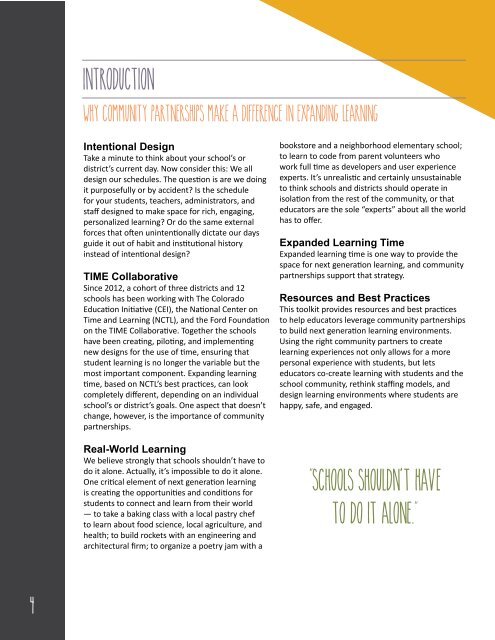DESIGNING COMMUNITY PARTNERSHIPS TO EXPAND STUDENT LEARNING A TOOLKIT
1i4Jz2x
1i4Jz2x
Create successful ePaper yourself
Turn your PDF publications into a flip-book with our unique Google optimized e-Paper software.
INTRODUCTION<br />
WHY <strong>COMMUNITY</strong> <strong>PARTNERSHIPS</strong> MAKE A DIFFERENCE IN <strong>EXPAND</strong>ING <strong>LEARNING</strong><br />
Intentional Design<br />
Take a minute to think about your school’s or<br />
district’s current day. Now consider this: We all<br />
design our schedules. The question is are we doing<br />
it purposefully or by accident? Is the schedule<br />
for your students, teachers, administrators, and<br />
staff designed to make space for rich, engaging,<br />
personalized learning? Or do the same external<br />
forces that often unintentionally dictate our days<br />
guide it out of habit and institutional history<br />
instead of intentional design?<br />
TIME Collaborative<br />
Since 2012, a cohort of three districts and 12<br />
schools has been working with The Colorado<br />
Education Initiative (CEI), the National Center on<br />
Time and Learning (NCTL), and the Ford Foundation<br />
on the TIME Collaborative. Together the schools<br />
have been creating, piloting, and implementing<br />
new designs for the use of time, ensuring that<br />
student learning is no longer the variable but the<br />
most important component. Expanding learning<br />
time, based on NCTL’s best practices, can look<br />
completely different, depending on an individual<br />
school’s or district’s goals. One aspect that doesn’t<br />
change, however, is the importance of community<br />
partnerships.<br />
Real-World Learning<br />
We believe strongly that schools shouldn’t have to<br />
do it alone. Actually, it’s impossible to do it alone.<br />
One critical element of next generation learning<br />
is creating the opportunities and conditions for<br />
students to connect and learn from their world<br />
— to take a baking class with a local pastry chef<br />
to learn about food science, local agriculture, and<br />
health; to build rockets with an engineering and<br />
architectural firm; to organize a poetry jam with a<br />
bookstore and a neighborhood elementary school;<br />
to learn to code from parent volunteers who<br />
work full time as developers and user experience<br />
experts. It’s unrealistic and certainly unsustainable<br />
to think schools and districts should operate in<br />
isolation from the rest of the community, or that<br />
educators are the sole “experts” about all the world<br />
has to offer.<br />
Expanded Learning Time<br />
Expanded learning time is one way to provide the<br />
space for next generation learning, and community<br />
partnerships support that strategy.<br />
Resources and Best Practices<br />
This toolkit provides resources and best practices<br />
to help educators leverage community partnerships<br />
to build next generation learning environments.<br />
Using the right community partners to create<br />
learning experiences not only allows for a more<br />
personal experience with students, but lets<br />
educators co-create learning with students and the<br />
school community, rethink staffing models, and<br />
design learning environments where students are<br />
happy, safe, and engaged.<br />
"SCHOOLS SHOULDN'T HAVE<br />
<strong>TO</strong> DO IT ALONE."<br />
4


